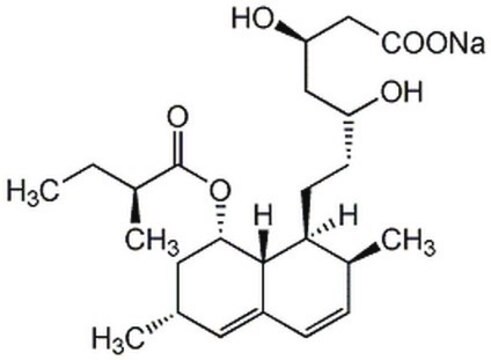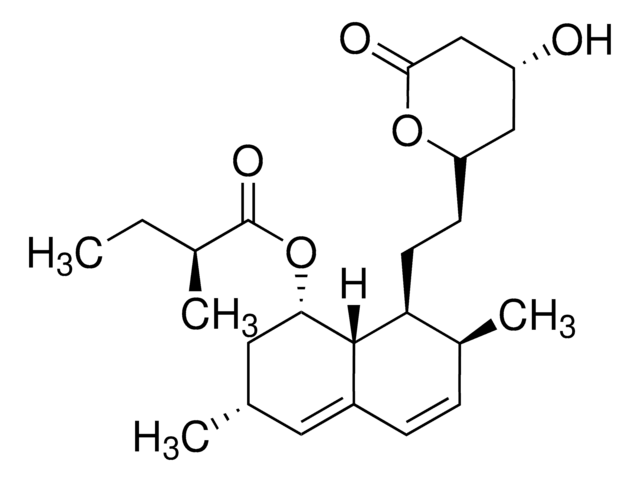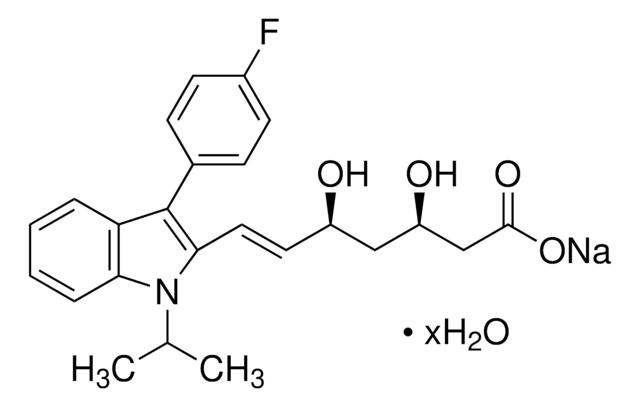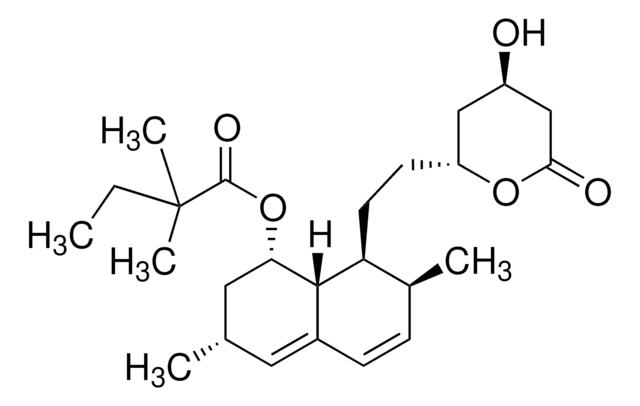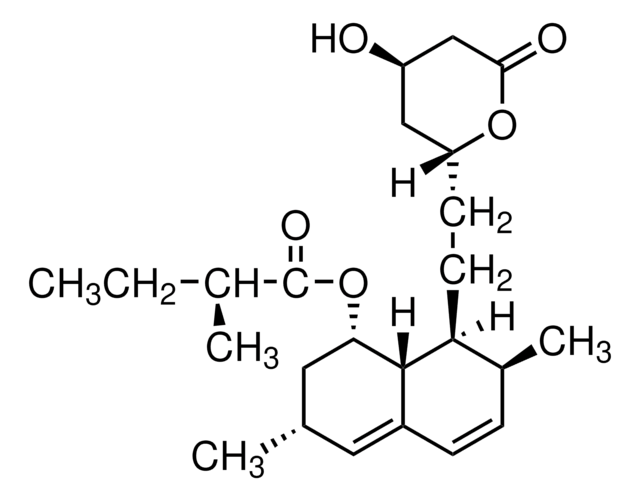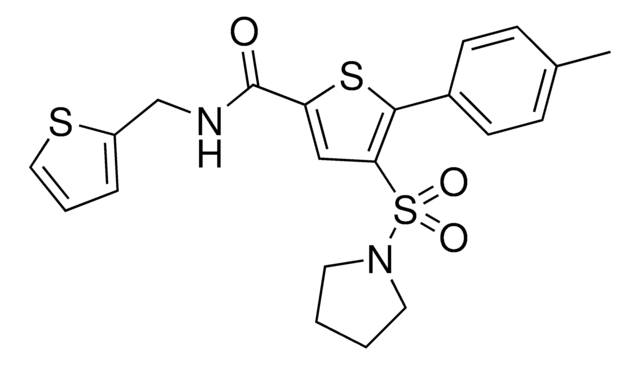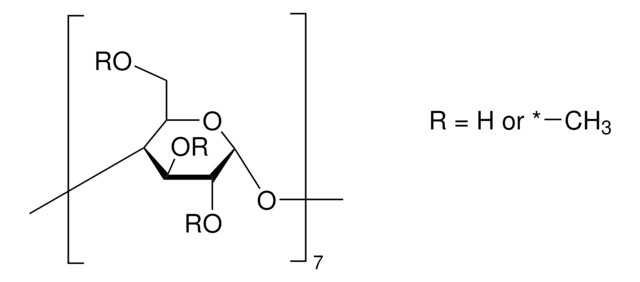438187
Lovastatin, Sodium Salt
InSolution ≥95%
Sinónimos:
InSolution Lovastatin, Sodium Salt
Iniciar sesiónpara Ver la Fijación de precios por contrato y de la organización
About This Item
Fórmula empírica (notación de Hill):
C24H37O6 · Na
Peso molecular:
444.54
Código UNSPSC:
51111800
NACRES:
NA.77
Productos recomendados
Nivel de calidad
Ensayo
≥95% (HPLC)
Formulario
liquid
fabricante / nombre comercial
Calbiochem®
condiciones de almacenamiento
OK to freeze
avoid repeated freeze/thaw cycles
protect from light
Condiciones de envío
dry ice
temp. de almacenamiento
−70°C
Descripción general
Carboxylate form of Lovastatin (Cat. No. 438185) that is active in whole cells and cell-free assays. Lovastatin is reported to be an anti-hypercholesterolemic agent that acts as a reversible competitive inhibitor of 3-hydroxy-3-methylglutaryl coenzyme A (HMG-CoA) reductase and blocks a series of biological events including activation of p21ras by insulin in 3T3-L1 fibroblasts and 3T3-L1 adipocytes, farnesylation of p21ras, which decreases the pool of intracellular Ras available for subsequent activation by growth factors (including insulin), and N-ras-induced neuronal differentiation. Causes cell cycle arrest in the late G1 phase. Shown to inhibit the stimulation of MAP kinase by insulin in HIRcB cells and block the transcription of the type-I SCR gene in THP-1-derived macrophages. Also blocks PDGF receptor tyrosine phosphorylation and MAP kinase activation by PDGF.
Acciones bioquímicas o fisiológicas
Cell permeable: yes
Primary Target
HMG-CoA reductase
HMG-CoA reductase
Reversible: yes
Envase
Packaged under inert gas
Advertencia
Toxicity: Harmful (C)
Forma física
A 10 mM (5 mg/1.13 ml) solution of Lovastatin, Sodium Salt (Cat. No. 438186) in H₂O.
Reconstitución
Following initial thaw, aliquot and freeze (-70°C). Aliquots are stable for up to 6 months at -70°C.
Otras notas
Rao, S., et al. 1999. Proc. Natl. Acad. Sci. USA96, 7197.
Carel, K., et al. 1996. J. Biol. Chem.271, 30625.
McGuire, T.F., et al. 1996. J. Biol. Chem.271, 27402.
Umetani, N., et al. 1996. Biochim. Biophys. Acta1303, 199.
Xu, X.Q., et al. 1996. Arch. Biochem. Biophys.326, 233.
Reusch, J.E.-B., et al. 1995. J. Biol. Chem.270, 2036.
Carel, K., et al. 1996. J. Biol. Chem.271, 30625.
McGuire, T.F., et al. 1996. J. Biol. Chem.271, 27402.
Umetani, N., et al. 1996. Biochim. Biophys. Acta1303, 199.
Xu, X.Q., et al. 1996. Arch. Biochem. Biophys.326, 233.
Reusch, J.E.-B., et al. 1995. J. Biol. Chem.270, 2036.
Información legal
CALBIOCHEM is a registered trademark of Merck KGaA, Darmstadt, Germany
Código de clase de almacenamiento
12 - Non Combustible Liquids
Clase de riesgo para el agua (WGK)
nwg
Punto de inflamabilidad (°F)
Not applicable
Punto de inflamabilidad (°C)
Not applicable
Certificados de análisis (COA)
Busque Certificados de análisis (COA) introduciendo el número de lote del producto. Los números de lote se encuentran en la etiqueta del producto después de las palabras «Lot» o «Batch»
¿Ya tiene este producto?
Encuentre la documentación para los productos que ha comprado recientemente en la Biblioteca de documentos.
Patrícia M R Pereira et al.
Clinical cancer research : an official journal of the American Association for Cancer Research, 26(23), 6215-6229 (2020-10-02)
Statins are cholesterol-depleting drugs used to treat patients with hypercholesterolemia. Preclinically, statins disrupt trafficking of receptors present at the cell membrane. Membrane receptors, defined as tumor biomarkers and therapeutic targets, are often internalized by an endocytic pathway. Indeed, receptor endocytosis
Nuestro equipo de científicos tiene experiencia en todas las áreas de investigación: Ciencias de la vida, Ciencia de los materiales, Síntesis química, Cromatografía, Analítica y muchas otras.
Póngase en contacto con el Servicio técnico
